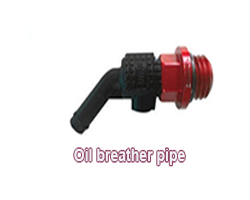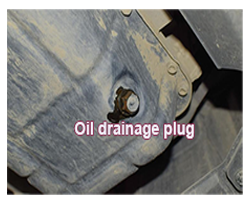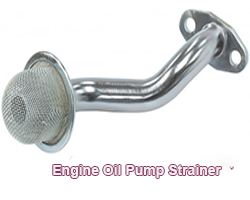
BLADDER: Describes the inflatable hollow bag used to flush out rust chips, applying an acid solution to remove any oil/gas residue, and coating the inside with a plastic compound in a petrol tank.
DIPSTICK: Describes the thin metal rod that passes into the oil sump used to determine the engine's quantity of oil. The oil level is marked on the rod according to pre-set level indicators.
GREASE SEAL: Describes a circular metal disk covered in either rubber or plastic used to keep grease and oil from leaking out and protects bearings from dirt and water.
GREASE GUN: Describes a small, hand-operated pump loaded with grease and used for lubricating the grease fittings on a vehicle.
GREASE NIPPLE: Describes a small, one-way valve used to inject grease into a bearing.
FUNNEL: Describes a cup-shaped object tapering at the bottom to a small hole and a spout used for pouring oil, fuel or water into relatively small openings.
LUBRICATION SYSTEM: Describes the system which circulates oil in an engine to lubricate its moving parts and bearings. Checking oil levels is carried out by way of an oil dipstick.
NIPPLE: Describes a small, one-way valve used for injecting grease into a bearing.
PAN: Describes a thin stamped cover bolted to the bottom of the crankcase that forms a sump for the engine oil and prevents foreign bodies from entering the engine.
SEPARATE LUBRICATION: Describes a principle in engine lubrication in which oil is no longer mixed with the fuel but fed by a metering pump from an independent oil tank to allow the engine components to be lubricated.
SINGLE-GRADE OIL: Describes a type of oil that can only be used within a narrow temperature range where its flow characteristics will allow adequate lubrication.
SLUDGE: Describes the thick, black deposit found that builds up the interior of an engine, where oil changes are not carried out regularly, caused by a mixture of dust, oil, gasoline, water, and blowby being whipped together by the moving parts over time.
STATIC SEAL: Describes a type of oil seal that controls liquid or materials flows between two stationary parts.
SUMP: Describes the part of the oil pan where the oil is stored.
UPPER-CYLINDER LUBRICATION: Describes a method used to introduce a lubricant to an intake manifold to lubricate the upper cylinder and valve guides.
VISCOSIMETER: Describes a commercial device used to determine the viscosity levels of a given sample of oil. The length of time required for the oil to begin to determine its viscosity.
VISCOSITY: Describes the measure of a particular variety of oil's ability to pour or be thick. Every container of oil is marked with the viscosity of the oil. Straight weight oil has a single number like 30 weight, while a lower number means the oil is thinner and particularly suitable for lower temperatures. In comparison, a higher number is better suited for use in hotter climates.
VISCOSITY INDEX: Describes the extent of an oil's ability to resist changes in viscosity when heated.
VISCOSITY CUP: Describes a conically shaped cup with a calibrated bore at the bottom that will see it flow out at the bottom of the cup at a determined time when filled with paint. To adjust the viscosity levels, thinners are added to the paint until the cup contents flow out in the time scale set out by the paint manufacturer.
VISCOUS COUPLING: Describes a particular variation of fluid coupling where the input and output shafts mate with thin, alternately spaced discs in a cylindrical chamber, filled with a viscous fluid that clings to the discs, restricting speed differences between the two shafts.
VISCOSITY INDEX IMPROVER: Describes a type of oil additive that reduces thinning at high temperature, thus improving the VI
VISCOUS MODE: Describes a particular operating condition in a viscous coupling with inner and outer parts rotating at different speeds, where torque is transmitted through the coupling, corresponding to the value of the resultant shearing velocity.
WET SUMP LUBRICATION: Describes a typical engine lubrication system where oil is stored in a pan below the crankshaft. A wet-sump lubrication system relies on gravity draining the circulated oil and therefore does not require a return pump.
All Categories
- Home Page
- Mechanics
Mechanics
Back- Camshaft
- Carburettors A-C
- Carburettors D-F
- Carburettors H-M
- Carburettors R-W
- Clutch B-C
- Clutch D-W
- Cooling System A-C
- Cooling System D-F
- Cooling System H-W
- Crankshaft A-C
- Crankshaft D-W
- Cylinder Head
- Engine A-D
- Engine E
- Engine F-L
- Engine M-S
- Engine T-X
- Filters
- Fuel Control Systems A-E
- Fuel Control Systems F
- Fuel Control Systems M-S
- Gearbox A-D
- Gearbox E-G
- Gearbox H-R
- Gearbox S-W
- Oil Control Systems C-W
- Oil Control Systems
- Pistons
- Auto Electrics
- Brakes,Suspension and Steering
Brakes,Suspension and Steering
Back- Axles
- Brakes A-B
- Brakes E-D
- Brakes FL
- Brakes M-R
- Brakes S-Y
- Differential
- Drive Systems
- Exhaust Systems A-D
- Exhaust Systems E
- Exhaust Systems F-Y
- Hydraulics
- Shock Absorbers
- Springs
- Steering A-R
- Steering S-V
- Suspension A-H
- Suspension I-R
- Suspension S-W
- Tires A-F
- Tires G-B
- Tires S-W
- WheelsA-I
- WheelsI-S
- Wheels T-V
- Bodywork
- Exterior Trim
- Interior Trim
- Paintwork
- Parts and Fittings
- Tools and Equipment
Tools and Equipment
Back 



- Site Map
- Privacy Policy
- Contact Us


All you need to know on how to acquire, restore and maintain a Classic Car
Step back in time to the renaissance age of the UK and European Car Industries
> All that is happening NOW in the world of classic cars.
Step into the golden decade of the UK and European Car Industries
and catch up with all the latest news and features.
Sign up for a Classic Car Info Twitter account.
ae4









